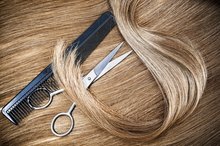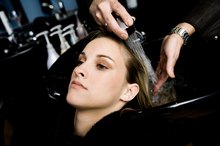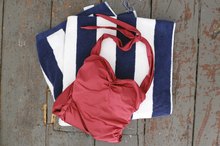How to Best Treat Dry, Damaged and Thin Permed Hair
While perms can give flat hair body and movement, they also may leave it in need of some extra attention. Perms use chemicals to alter the shape of your hair; it might start with a smooth appearance, but will start to show signs of damage as your hair grows out. The process can also lead to excess breakage and thinning in hair that is already fine. Permed hair needs a healthy dose of moisture and protein to keep it strong and manageable. Add a weekly treatment to your haircare routine, and switch up your daily styling tools to keep your permed hair in check.
Read more about how to treat damaged hair and split ends.
Place 2 tablespoons of canola oil into a blender. Add half of a banana and one egg. The canola oil will deeply condition your hair, while the banana and egg coat it in protein to strengthen the follicle. Turn the blender on and allow it to run until blended but still thick.
How to Restructure Brittle Hair
Learn More
Coat your hair from roots to tips with the mixture. Cover with a plastic shower cap.
Place a hair towel in the dryer until it's hot, and wrap it around the shower cap. The heat from the towel will help the mask absorb into your hair thoroughly.
Can I Repair Chemically Treated Hair Loss?
Learn More
Allow the mask to sit in your hair for an hour and rinse it out using warm water. Work a dime-size amount of sulfate-free shampoo into your roots. Sulfate-free shampoos will keep your hair's natural oils intact to prevent frizz, and should be used every time you wash permed hair.
Coat the bottom 2 inches of your hair in a silicone-based conditioner and allow it to sink in for 3 minutes before rinsing completely. Silicone based conditioners coat the hair shaft to add shine, while sealing split ends. Use this every time you wash.
Gently squeeze the ends of your hair dry with a microfiber towel. Microfiber towels are less abrasive than regular towels, and will prevent split ends.
Pull through a dime-size amount of hair oil through the ends of your hair. Comb your hair from root to tip using a wide-toothed comb to distribute the product and detangle. Use a natural hair oil, such as Argan or Coconut oil 2. Choose a light formula if you have fine hair. Oils seal the cuticle and protect it from humidity without the need for heat.
Read more about how to repair damaged hair without cutting it.
Allow your hair to air-dry and reapply the oil as necessary. Hot styling tools will remove moisture from your hair and damage it further, so avoid the blow-dryer whenever possible.
Tips
Use a mask treatment once a week. Wash your hair with a sulfate-free shampoo and silicone-based conditioner every other day to keep your natural oils intact.
Only comb your hair while it is wet, and use a natural-bristle brush to detangle dry hair as needed. Excess brushing leads to fallout.
Related Articles
References
- Naturally Curly: How to Fix a Bad Perm
- Elle: 10 All-Natural Tips for All Hair Types
- Gavazzoni Dias MF. Hair cosmetics: An overview. Int J Trichology. 2015;7(1):2-15. doi:10.4103/0974-7753.153450
- Faria P, Camargo L, Carvalho R, Paludetti L, Velasco M, Gama R. Hair protective effect of argan oil (Argania spinosa kernel oil) and cupuassu butter (Theobroma grandiflorum seed butter) post treatment with hair dye. JCDSA. 2013;3(3A):40-44. doi:10.4236/jcdsa.2013.33A1006
- Dreher ML, Davenport AJ. Hass avocado composition and potential health effects. Crit Rev Food Sci Nutr. 2013;53(7):738-50. doi:10.1080/10408398.2011.556759
- Ahmad Z. The uses and properties of almond oil. Complement Ther Clin Pract. 2010;16(1):10-2. doi:10.1016/j.ctcp.2009.06.015
- Komane BM, Vermaak I, Kamatou GPP, Summers B, Alvaro, Viljoen AM. Beauty in baobab: a pilot study of the safety and efficacy of Adansonia digitata seed oil. Brazi J of Pharmaco. 2017;27(1):1-8. doi:10.1016/j.bjp.2016.07.001
- American College of Allergy, Asthma, and Immunology. Tree nut allergy.
Writer Bio
Celeigh O'Neil has been writing professionally since 2008. She has a Bachelor of fine arts from the University of Ottawa, as well as degrees in fashion illustration/design, digital arts and certification in hair and makeup artistry. O'Neil was a frequent contributor to Toronto's "Dialog" newspaper and has worked as an instructional writer, creating lessons in fashion, art and English for students of all ages.








